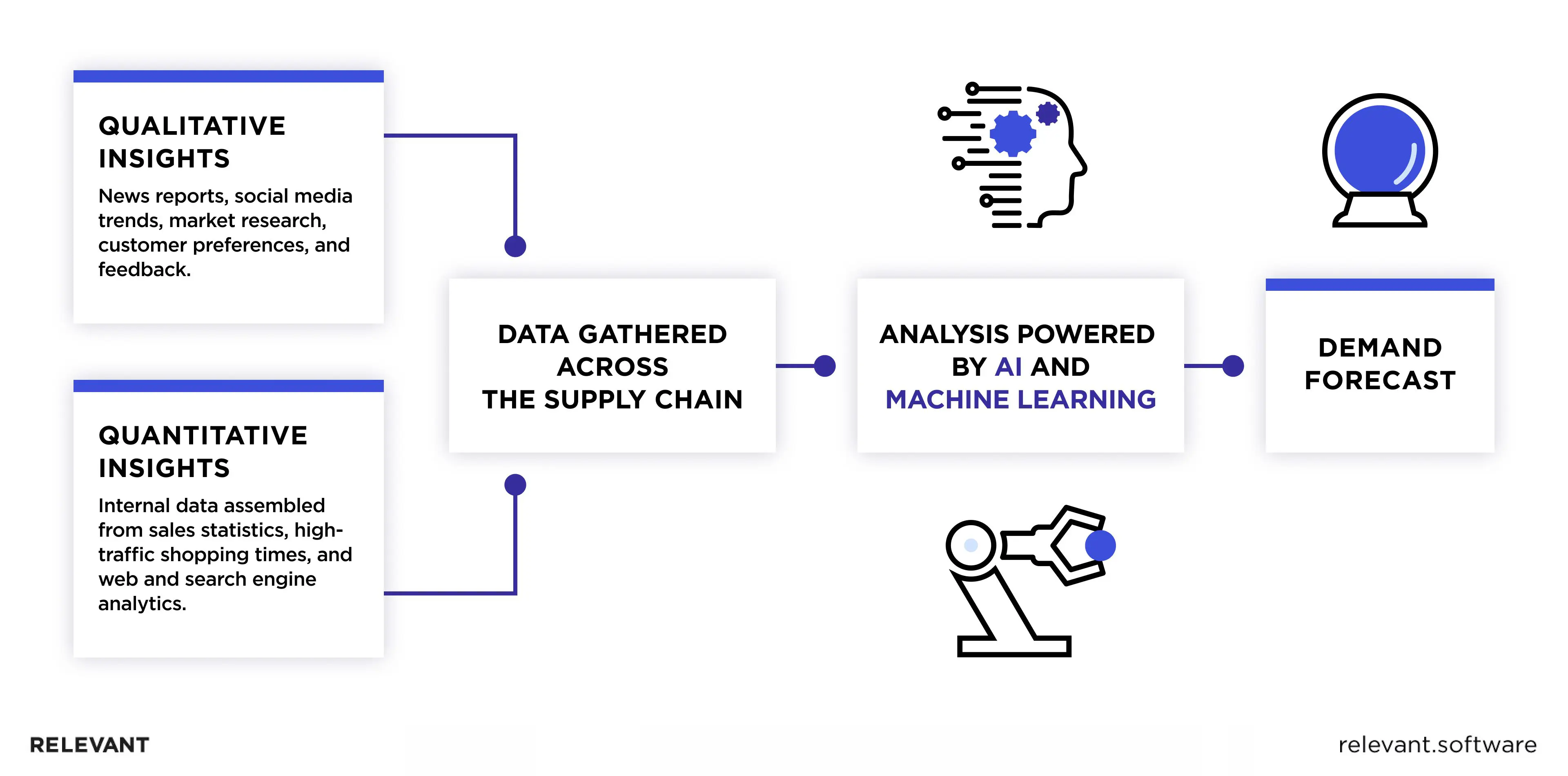Demand Forecasting in Supply Chain: A Comprehensive Guide

In an era where market dynamics shift at breakneck speed, the importance of efficient supply chain management cannot be overstated. Central to this is the concept of demand forecasting—a process that has moved far beyond mere speculation to become a strategic cornerstone in modern business.
The aim of demand forecasting in supply chain management is simple yet vital: to optimize efficiency and minimize costs. Respectively, the methods and practices involved in achieving this goal are no longer rudimentary. Predictive AI-based technologies present an opportunity to construct a precise demand forecasting strategy for competent logistics.
This article focuses on the nuances of demand forecasting, unraveling its transformative potential in building an agile, resilient, and cost-effective supply chain. Thus, continue reading, discover fresh perspectives, and equip yourself with the essential information required to drive your enterprise forward.
Understanding Demand Forecasting
Grasping the essence of demand forecasting in a supply chain starts by acknowledging its pivotal role in crafting a company’s logistic tactics.
It’s a cyclical process using past data, market scrutiny, and complex models to predict future demand trends. This prediction serves as a foundation for managing supply chains, controlling inventory, planning production, and making strategic business decisions. It steers the careful equilibrium between fulfilling customer requirements and preserving cost-effectiveness, ultimately shaping the firm’s profits and market position.

Why Accurate Demand Planning Matters?
Imagine a global electronics manufacturer gearing up for the launch of its highly anticipated smartphone. With fierce competition in the market and a limited production capacity, accurate logistics forecasting becomes the key to success.
By leveraging historical sales data, market trends, and consumer insights, the company predicts a surge in demand during the holiday season. Armed with this forecast, the manufacturer strategically aligns its supply chain operations, ensuring an adequate inventory of components, optimizing production schedules, and securing efficient logistics for timely product delivery.
As the holiday season approaches, the demand forecast proves to be remarkably accurate. The company avoids stockouts by having the right quantity of smartphones available in stores, satisfying customer demand without excess inventory. Consequently, the company maximizes revenue while minimizing the risk of costly overstocking.
In this example, demand forecasting empowers the company to allocate resources efficiently, optimize production capacity, reduce costs associated with excess inventory or missed sales opportunities, and maintain a competitive edge in the fast-paced consumer electronics market. Through effective demand forecasting for logistics, businesses can navigate uncertainties and capitalize on market opportunities, driving sustainable growth and profitability.
Demand forecasting methods in the supply chain
Numerous types of demand forecasting in supply chain management exist, all of which hinge on data as their foundational element. This data can manifest in the shape of historical sales data or valuable insights acquired through proactive research. It is evident that the abundance of available data directly correlates with the accuracy and value of demand forecasting endeavors.
Time-Series Forecasting
It is a data-driven method, relying on past patterns to predict future demand. It operates on the principle that history tends to repeat itself. Critics may contend that it disregards external elements such as market fluctuations or rivals’ maneuvers. However, for stable markets with consistent demand, it remains an incredibly reliable, straightforward, and cost-effective method.
Causal Forecasting
It takes it a step further by identifying cause-and-effect relationships between variables, such as the impact of economic indicators or marketing efforts on demand. Critics may deem it complex, but there’s no denying its predictive power when causal relationships exist. In the right hands, it can unveil correlations that drive smarter business decisions.
Qualitative Forecasting
This method is often used when historical data is lacking or a new market entry is planned, relying on expert opinion, market research, and intuition. While some may argue against its subjective nature, it is indispensable in scenarios where tangible data is scarce. Its effectiveness hinges on the depth of industry knowledge and expertise employed, making it an essential tool in the forecaster’s arsenal.
AI and ML Methods (Neural Networks)
Finally, we have AI and ML Methods, like Neural Networks, pushing the boundaries of predictive accuracy. These techniques harness the power of machine learning to detect complex, non-linear relationships and adapt to new data. Skeptics might point out their complexity and resource intensity, but their unrivaled ability to handle large data sets and detect hidden patterns arguably puts them at the forefront of demand forecasting innovation.
Surely, each method comes with its own set of advantages and potential drawbacks. It is the effective integration and appropriate application of these methods that enable logistics businesses to navigate the ebb and flow of market demand, reinforcing the argument that adept demand forecasting is a logistical imperative.

Benefits of Demand Forecasting in Supply Chain
Demand forecasting is an essential strategy, providing a blueprint for manufacturers to navigate market changes, mitigate risks, and capture opportunities. This strategy bolsters supply chain operations, aids in fulfilling customer needs, drives cost reductions, and enhances competitiveness. Here are some compelling benefits that demand forecasting brings to businesses:
Enhanced Inventory Management
Demand forecasting promotes superior inventory control by precisely anticipating consumer demand. This enables businesses to maintain optimal stock levels, minimizing excess inventory costs and stockouts. Through streamlined inventory, waste elimination, and a lean supply chain, operational efficiency is boosted, resulting in substantial cost savings.
Increased Operational Efficiency
Demand forecasting drives increased operational efficiency by allocating resources effectively based on forecasted demand patterns. This prevents underutilization or overutilization of resources, eliminates bottlenecks, and improves overall productivity. The effective deployment of resources permits enterprises to react promptly to market requirements, secure a competitive advantage, and grasp expansion possibilities.
Better Production Planning
Accurate logistics demand forecasting empowers businesses to achieve better production planning and efficiency. Aligning production schedules and capacity with customer requirements minimizes idle time, reduces setup costs, and avoids production backlogs. Optimized production planning improves efficiency, reduces lead times, and enhances overall supply chain performance.
Improved Customer Satisfaction
Demand forecasting significantly impacts customer satisfaction by ensuring product availability when and where customers need them. Meeting customer expectations consistently fosters loyalty, strengthens relationships, and drives recurring revenue.

Steps to Implement Demand Forecasting
Implementing demand forecasting in your logistics operations can be a game-changer, revolutionizing how you manage your supply chain. To initiate this transformative journey, adhere to these crucial steps:
- Commence with Data Collection and Preparation. The initial step involves accumulating and preparing high-quality data. Collect past sales figures, market patterns, consumer preferences, and any relevant external factors. Guarantee the accuracy and completeness of the data, as it constructs the groundwork for credible demand forecasting.
- Proceed to Model Selection and Training. Subsequently, identify the most fitting forecasting model in line with your business requisites. Whether it’s time-series models, regression studies, or machine learning algorithms, opt for the approach that corresponds with your data traits and forecasting needs. Train the chosen model utilizing historical data to assure its precision and efficiency.
- Advance to Integration with Supply Chain Management Systems. Incorporate the demand forecasting process with your supply chain management systems. Collaborate with stakeholders across divisions to harmonize forecasts with procurement, production, and inventory management. This integration improves coordination and empowers proactive decision-making to effectively cater to customer demands.
Best Practices in Demand Forecasting
To heighten forecasting precision and fully exploit its advantages, enterprises must conform to certain fundamental best practices in demand forecasting:
Use high-quality data
Depend on precise and exhaustive data to enhance the dependability of your forecasts. Consistently cleanse, authenticate, and refresh your data to guarantee its pertinence and accuracy. Utilize sophisticated data analytics methods to reveal concealed insights and patterns.
Choose the right forecasting method
Choose the apt forecasting technique predicated on the characteristics of your business, product array, and demand tendencies. Take into account elements like seasonality, trends, and market fluctuations to elect the method that optimally aligns with your specific prerequisites.
Understand demand drivers
Gain a deep understanding of the drivers that influence demand in your industry. Identify key market factors, customer behavior, economic indicators, and competitor activities. Integrate this valuable knowledge into demand forecasting models in supply chain to elevate the accuracy and depth of your predictions.
Collaborate across departments
Facilitate cross-departmental collaboration between sales, marketing, operations, and finance teams. Foster open communication to gather insights, share knowledge, and align strategies. Collaboration enhances the accuracy of forecasts and facilitates proactive decision-making.
Regularly review and update forecasts
Demand patterns transform with time, hence it’s vital to consistently scrutinize and refresh your forecasts. Monitor market dynamics, customer preferences, and other relevant factors to ensure your forecasts remain accurate and relevant. Incorporate feedback from stakeholders and adjust your models accordingly.
Use technology and software
Leverage advanced technology and demand forecasting software to streamline the process. Utilize software solutions that offer automation, data visualization, and real-time insights. These tools enhance forecasting accuracy, efficiency, and scalability.
Incorporate AI and Machine Learning
Capitalize on the potency of forecasting demand in supply chain using machine learning algorithms. This helps to uncover complex patterns, detect anomalies, and generate more accurate forecasts. Incorporating AI and ML enhances the precision and agility of your demand forecasting capabilities.
By following these steps and best practices, you can unlock the full potential of demand forecasting in your logistics operations. You’ll optimize operational efficiency, elevate customer satisfaction levels, and secure a distinct competitive advantage in the ever-evolving marketplace.

Overcoming Common Challenges in Demand Forecasting
Demand forecasting poses numerous obstacles that businesses should surmount to optimize their supply chain operations. By proactively addressing these hurdles, organizations can elevate their forecasting accuracy and drive informed business decisions. Below we outline prevailing obstacles encountered in demand forecasting, accompanied by effective strategies to conquer them:
Data quality and availability
The first challenge in demand forecasting often lies in the data itself. To generate reliable forecasts, businesses must access accurate, complete, and timely data. Overcoming this hurdle involves implementing comprehensive data management processes and systems to collect, clean, and process data from all relevant sources. The use of advanced analytics and machine learning tools can also help improve data quality by identifying and correcting inconsistencies, gaps, or errors in the data.
Lack of integration
Lack of integration between different data sources and systems can be another major challenge. It can lead to information silos and inconsistent data, making it hard to get a holistic view of demand. Overcoming this issue requires the use of robust integration tools and platforms that can connect disparate systems and data sources, facilitating seamless data flow and providing a unified view of demand across different channels, regions, and products.
Demand volatility
Demand can be highly volatile, influenced by numerous unpredictable factors such as economic conditions, consumer behavior, and market competition. To navigate this volatility, businesses can use advanced predictive analytics and machine learning algorithms that take into account these variables to create more robust and adaptable demand forecasts. Scenario planning and stress testing can also be used to understand the potential impact of different demand scenarios and plan accordingly.
Shortage of competent staff
Having the right personnel with the necessary skills is vital for effective demand forecasting. In order to overcome this challenge, it is imperative for businesses to allocate resources towards continuous training and development initiatives, fostering in-house expertise in demand forecasting. In addition, they can also leverage external consultants or outsourcing partners to supplement their internal resources and capabilities.
Best Supply Chain Forecasting Software
In the competitive environment of supply chain forecasting software, there are plenty of offerings that can solve organizational problems at some level. Let’s see what we have.
- Oracle Demantra is renowned for its robust demand management capabilities, providing advanced analytics and optimization tools to improve forecasting accuracy and enhance supply chain visibility. Oracle Demantra, equipped with its extensive range of features, empowers businesses to embrace data-driven decision-making and fine-tune their inventory levels for optimal performance.
- SAP Integrated Business Planning (IBP) excels in its ability to integrate data from multiple sources, enabling seamless collaboration across departments and optimizing end-to-end supply chain processes. With its powerful analytics and forecasting functionalities, SAP IBP allows businesses to align their demand plans with financial goals and make informed decisions in real-time.
- SAS Demand-Driven Planning and Optimization is highly regarded for its sophisticated analytics and machine learning algorithms. Harnessing these capabilities empowers businesses to generate precise demand forecasts and optimize their supply chain operations. SAS Demand-Driven Planning and Optimization empower businesses to proactively identify trends, optimize inventory levels, and enhance overall operational efficiency.
- JDA Demand Planning is globally acknowledged for its exhaustive forecasting and inventory control abilities. Utilizing sophisticated algorithms, it empowers businesses to calibrate inventory levels, decrease stock shortages, and trim down costs. Its user-friendly interface and analytical instruments facilitate the crafting of precise demand plans and encourage informed decision-making.
- IBM Planning Analytics stands out for its powerful forecasting and scenario modeling capabilities. With its advanced analytics capabilities, IBM Planning Analytics helps businesses identify trends and patterns, enabling proactive decision-making in a dynamic business environment. It allows organizations to create accurate demand plans, align them with financial objectives, and optimize their supply chain operations.
In pursuing ultimate supply chain forecasting software, organizations must conduct a comprehensive evaluation, balancing immediate needs with future aspirations. While off-the-shelf solutions have merits, custom software is optimal for achieving peak supply chain performance and gaining a sustainable competitive advantage.
Custom software offers unparalleled flexibility, allowing organizations to tailor it precisely to their unique processes, requirements, and objectives, optimizing every aspect of supply chain forecasting. Though it may require a higher initial investment, its long-term benefits outweigh the costs, providing a competitive edge by addressing industry-specific challenges.
Sum It Up
In conclusion, demand planning and procurement form the backbone of a highly effective supply chain management structure. The ability to comprehend customer requirements and optimize the buying process holds immense potential for businesses to achieve cost savings, drive profitability, and elevate overall customer satisfaction.
The steps outlined above, which include stakeholder synchronization, accurate demand forecasting, efficient inventory management, strategic supplier collaboration, and implementing a robust system, are indispensable for mastering demand planning and procurement.
Given the benefits, we encourage you to partner with us – Relevant Software, a frontrunner in building customized, scalable, and harmoniously integrated supply chain software solutions. Leveraging our expertise and steadfast dedication to perfection, we can help you to fine-tune your supply chain operations, boost forecasting accuracy, and drive measurable results. Contact us if you are determined to thrive in logistics.



